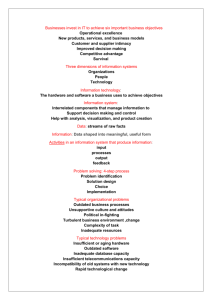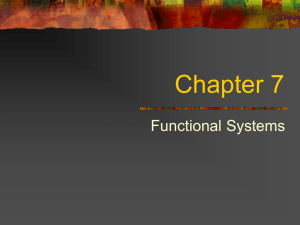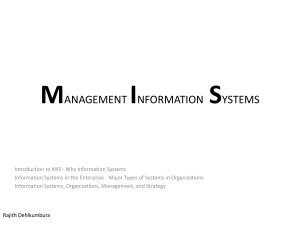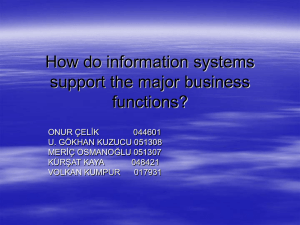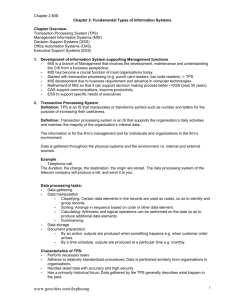Questions & Answers for mid-term examination
advertisement
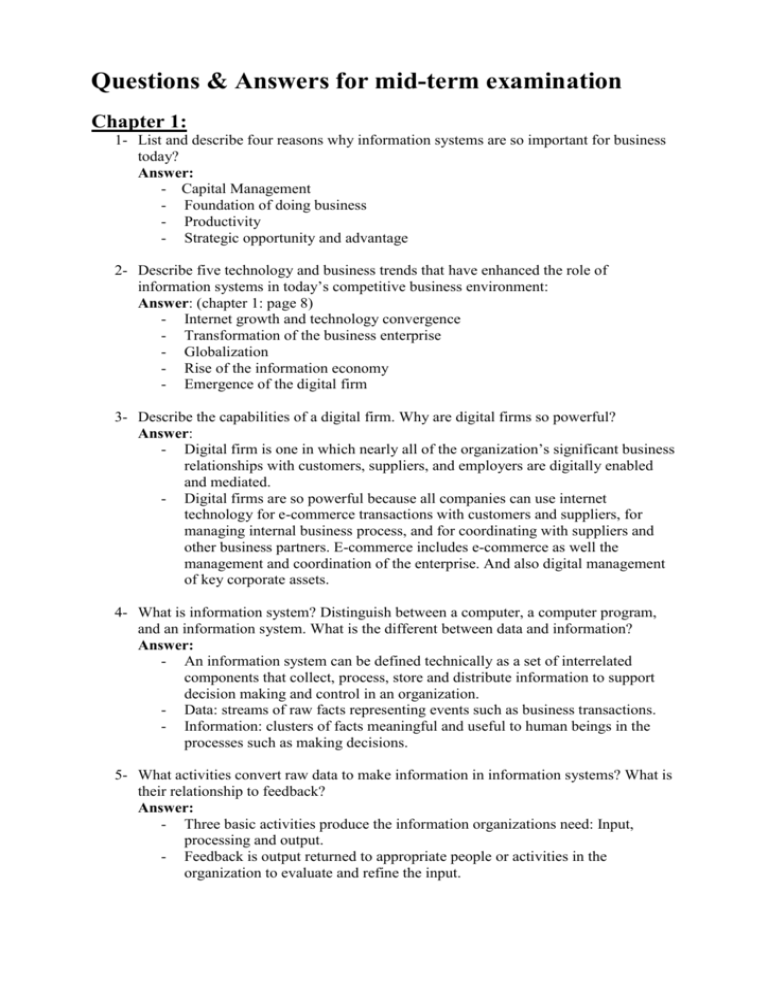
Questions & Answers for mid-term examination Chapter 1: 1- List and describe four reasons why information systems are so important for business today? Answer: - Capital Management - Foundation of doing business - Productivity - Strategic opportunity and advantage 2- Describe five technology and business trends that have enhanced the role of information systems in today’s competitive business environment: Answer: (chapter 1: page 8) - Internet growth and technology convergence - Transformation of the business enterprise - Globalization - Rise of the information economy - Emergence of the digital firm 3- Describe the capabilities of a digital firm. Why are digital firms so powerful? Answer: - Digital firm is one in which nearly all of the organization’s significant business relationships with customers, suppliers, and employers are digitally enabled and mediated. - Digital firms are so powerful because all companies can use internet technology for e-commerce transactions with customers and suppliers, for managing internal business process, and for coordinating with suppliers and other business partners. E-commerce includes e-commerce as well the management and coordination of the enterprise. And also digital management of key corporate assets. 4- What is information system? Distinguish between a computer, a computer program, and an information system. What is the different between data and information? Answer: - An information system can be defined technically as a set of interrelated components that collect, process, store and distribute information to support decision making and control in an organization. - Data: streams of raw facts representing events such as business transactions. - Information: clusters of facts meaningful and useful to human beings in the processes such as making decisions. 5- What activities convert raw data to make information in information systems? What is their relationship to feedback? Answer: - Three basic activities produce the information organizations need: Input, processing and output. - Feedback is output returned to appropriate people or activities in the organization to evaluate and refine the input. 6- What is purpose of an information system from a business perspective? What role does it play in the business information value chain? Answer: - From a business perspective, information systems are part or a series of valueadding activities for acquiring, transforming, and distributing information that managers can use to improve decision making, enhance organizational performance, and, ultimately, increase firm profitability. - Using information systems effectively requires an understanding of the organization, management, and information technology shaping the systems. An information system creates value for the firm as an organizational and management solution to challenges posted by the environment. 7- What is information systems literacy? How does it differ from computer literacy? Answer: - Information systems literacy: broad-based understanding of information systems that includes behavioral knowledge about organization, management and individuals using information systems as well as technical knowledge about computers. - Computer literacy: Knowledge about information technology, focusing on understanding how computer technologies work. 8- What are the organizational, management, and technology dimensions of information systems? Answer: - Organizational dimension: people, structure, business processes, politics, and culture. - Management dimension: Sense makers, decision makers, planners, innovators or new processes, and leaders (set agendas). - Technology dimensions: Hardware, software, storage, communication technology, and network. 9- What are the Internet and the World Wide Web? How have they changed the roles played by information systems in organizations? Answer: - Internet is the world’s largest and most widely used network. - World Wide Web is a system with universally accepted standards for storing, retrieving, formatting, and displaying information a networked environment. 10- Why do some firms obtain greater value from their information systems than others? What role do complementary assets and organizational and management capital play? Answer: - Some firms obtain greater value from their information systems than others because…………………………………………….. - Role of complementary assets play: New business processes, Management behavior, Organizational culture and training. - Role of organizational and management capital play: supportive business culture that values efficiency and effectiveness, Efficient business processes, decentralization of authority. Highly distributed decision rights and a strong information system development team. 11- Distinguish between a behavioral and a technical approach to information systems in terms of the questions asked and the answers provided. What major disciplines contribute to an understanding of information systems? Answer: - The technical approach to information systems emphasizes mathematically based models to study information systems. And Behavioral approach concentrates on changes in attitudes, management and organizational policy, and behavior. - Major disciplines contribute to an understanding of information systems are: + Technical approaches: computer science, management science and Operations research. + Behavioral approaches: Psychology, sociology and economics. 12- What are the key management challenges involved in building, operating and maintaining information systems today? Answer: - The information systems investment challenge: How can organization obtain business value from their information system? - The strategic business challenge: What complementary assets are needed to use information technology effectively? - The globalization challenge: How can firm understand the business and system requirements of a global economic environment? - The information technology infrastructure challenge: How can organization develop an information technology infrastructure that can support their goals when business conditions and technologies are changing so rapidly? - Ethic and security: The responsibility and control challenge: How can organization ensure that their information systems are used in an ethically and socially responsible. Chapter 2: 1- Identify and describe the three levels of the organizational hierarchy. Which types of information systems serve each level? Answer: The three levels of the organizational hierarchy: - Senior Managers - Middle Managers - Operational Managers Types of information systems serve each level: - Operational-level systems: support operational mangers, keeping track of the elementary activities and transactions. - Management-level systems: serve the monitoring, controlling, decisionmaking, and administrative activities of middle managers. - Strategic-level systems: help senior management tackle and address strategic issues. 2- List and briefly describe the major types of system in organization? Answer: - Transaction Processing Systems (TPS): are the basic business systems that serve the operational level of the organization. And it is also a computerized system that performs and records the daily routine transactions necessary to conduct business. - Management Information Systems (MIS): serve the management level of the organization, providing managers with reports and often-online access to the organization’s current performance and historical records and primarily serve the functions of planning, controlling, and decision-making. - - Decision-Support System (DSS): also serve the management level or the organization. DSS help mangers make decisions that are unique, rapidly changing, and not easily specified in advance. Executive Support System (ESS): serve the strategic level of the organization. They address nonroutine decisions requiring judgment, evaluation, and insight because there is no agreed on procedure for arriving at a solution. 3- What are the five types of TPS in business organizations? What functions do they perform? Give example of each. Answer: Five types of TPS with example: - Sale/Marketing Systems (eg. Sale management, customer service…) - Manufacturing/Production Systems (eg. Purchase order, scheduling,…..) - Finance/Accounting Systems (eg. General ledger, payroll…….) - Human Resources Systems (eg. Personnel records, training,…….) - Other types of TPS that are unique to a particular industry. (eg. University: admissions, grade records,…..) 4- What are the characteristics of MIS? How do MIS differ from TPS? From DSS? Answer: - Characteristics of MIS: (Inputs: high volume transaction level data; Processing: simple models; Outputs: summary reports; Users: Middle Manager) - MIS differ from TPS: MIS serve at management level and TPS serve at Operational level. - MIS differ from ESS: MIS serve at management level and ESS serve at strategic level. 5- What are the characteristics for DSS? How do they differ from those of ESS? Answer: - Characteristics for DSS: (Inputs: transaction level data; Processing: Interactive; Outputs: Decision analysis; Users: Professional and staff) - DSS differ from ESS: DSS serve at management level and ESS serve at strategic level and its characteristics are: Inputs: Aggregate data; Outputs: projections; Users: senior managers. 6- Describe the relationship between TPS, MIS, and ESS. Answer: - The relationship between TPS, MIS, and ESS: TPS are typically a major source of data for other systems, data also be exchanged to MIS to produce reports, whereas ESS are primarily a recipient of date from lower-level systems. 7- List and describe the information systems serving each of the major functional areas of a business. Answer: - Sale and Marketing Systems: System Description Order processing Pricing analysis Enter, process, and track orders Determine prices for products and services Prepare 5 years sales forecasts Sale and forecasting - Manufacturing and Production Systems System Description Machine control Production planning Facilities location - Finance & Accounting Systems System Description Account Receivable Budgeting Profit planning - Control the actions of machines and equipment Decide when and how many products should be produced Decide where to locate new production facilities. Tracks money owed the firm Prepares short-term budgets Plans long-term profits Human Resource Systems System Description Training and Development Compensation analysis Human Resource planning Organizational Level Operational Management Strategic Organizational Level Operational Management Strategic Organizational Level Operational Management Strategic Organizational Level Operational Tracks employee training, skills, and performance appraisals Monitors the rang and Management distribution of employee wages, salaries, and benefits Plans the long-term labor force Strategic needs of the organization 8- What is a business process? Give two examples of processes for functional areas of the business and one example of a cross functional process. Answer: - Business process refer to sets of logically related activities for accomplishing a specific business result, and also refer to the unique ways in which organization and management coordinate these activities. - Example for functional area of business process: (Finance and Accounting: paying creditors, creating financial statements and managing cash accounts); (Human Resources: hiring employees, evaluating employees’ job performance and enrolling employees in benefits plans) - Example of a cross functional process: Order fulfillment process (Sales Department: Generate order and submit order; Accounting Department: Check credit and approve credit and then Manufacturing & Production department: Assemble product and ship product, and finally Accounting Department: Generate invoirce). 9- Why are organizations trying to integrate their business processes? What are the four key enterprise applications for organization-wide process integration? Answer: - Organizations are trying to integrate their business processes because they want to enhance the performance of the organizations as a whole. The system takes advantage of corporate intranets and web technologies that enable the efficient transfer of information within the firm and to partner firms. And these systems are inherently cross-level, cross-functional, and business process oriented. - The four key enterprise applications: Enterprise Systems, Supply Chain Management Systems, Customer Relationship Management Systems, and Knowledge Management Systems. 10- What are enterprise systems? How do they change the way an organization work? Answer: - Enterprise Systems, also known as enterprise resource planning systems, provide a single information system for organization-wide coordination and integration of key business processes. - Information that was previously fragmented in different systems can seamlessly flow throughout the firm so that it can be shared by business processes in manufacturing, accounting, human resources, and other areas. 11- What are supply chain management systems: How do they benefit business? Answer: - Supply chain management systems are more outward facing, focusing on helping the firm manage its relationship with suppliers to optimize the planning, sourcing, manufacturing, and delivery of products and services. Theses systems provide information to help suppliers, purchasing firms, distributors, and logistics companies coordinate, schedule, and control business processes for procurement, production, inventory management, and delivery or products and services. - Benefit to business: Decide when and what to produce, store, and move; Rapidly communicate orders; Track the status of orders; Check inventory availability and monitor inventory levels; Reduce inventory, transportation, and warehousing costs; Track shipments; Plan production based on actual customer demand; Rapidly communicate changes in product design. 12- What are customer relationship management systems? How do they benefit business? Answer: - Customer Relationship Management Systems focus on coordinating all of the business processes surrounding the firm’s interactions with its customers in sales, marketing, and service to optimize revenue, customer satisfaction, and customer retention. - Users can manage and evaluate marketing campaigns across multiple channels, including e-mail, direct mail, telephone, the web, and wireless message. 13- What is the role of knowledge management systems in the enterprise? What organizational processes are supported by knowledge management applications? Answer: Role of Knowledge Management Systems: - Collects relevant knowledge and make it available wherever and whenever it is needed. - Support business processes and management decisions - Also link the firm to external sources of knowledge - Support processes for acquiring, storing, distributing, and applying knowledge. Organizational process that supported by KM applications: - Acquiring knowledge - Storing knowledge - Distributing knowledge - Apply knowledge 14- What are the challenges posed by the existence of various types of information systems in the enterprise? How can these challenges be addressed? Answer: Challenges: - Integration and the whole firm view: Given the different interests and perspectives within a firm, it is difficult to achieve consensus about the need for the whole firm viewpoint. - Management and employee training: Training a large number of employees on many systems in a large organization involves commensurately large investments. - Accounting for the cost of systems and managing demands for systems: Given the large number of different types of systems in a firm, and the large number of people involved with using them. It is a complex task to understand which systems are truly necessary and productive with high returns on investment. Challenges be addressed: - Inventory the firm’s information systems: Develop a list of firm-wide information requirements to give a 360-degree view of the most important information needs of the firm. - Employee and Management education: Ensure that you understand how much training is required. - Account for the costs and benefits: Develop an accounting system for information services firm-wide.
